Our attempts to find ourselves—to understand who we are, where we belong in the world, and how we can fulfill ourselves—require a certain amount of insight and strength. Whether we lead meaningful and fulfilling lives also depends entirely on the relationship between our ego and our Real Self. If this relationship is in balance, everything falls nicely into place. All of these teachings from the Pathwork Guide are pointing to this same thing, prying at it from a multitude of directions to help us open to this truth as our personal experience.
We can also call our Real Self the universal life principle, which manifests in each and every one of us. It is life itself. For it is unending consciousness in both the deepest and the highest sense. It is pleasure supreme and infinite movement all rolled into one. Since it is life, it can never die. It’s the very essence of everything that moves and breathes. It is eternal vibration. It knows everything and since it can only be true to its own nature, it is constantly creating and furthering itself.
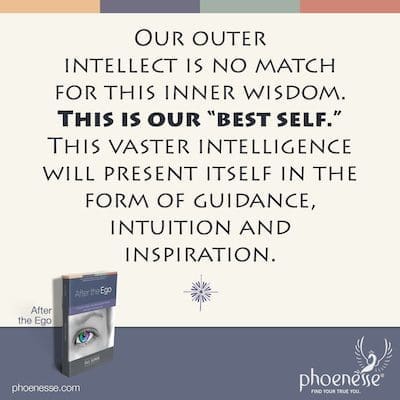
Each person—each individual consciousness—is this universal consciousness. We’re not just part of it, for that would imply we are just a little drop of it. No, we actually are universal consciousness. And this original consciousness, or creative life principle, can take many forms. When we each incarnate as those various forms, we forget our connection with the origin. At that point, a disconnection occurs. We continue to exist and we still contain the universal consciousness, but we become oblivious to our own nature. We lose track of basic spiritual laws and we lose sight of our potential. This, in a nutshell, describes the general state of human consciousness.
When we start becoming aware of this Real Self, we realize that in fact it’s always been there. We just haven’t noticed it because we were under the impression we were cut off from it. So it’s not quite right to say our Real Self “manifests.” More correctly, we begin to notice it. We may pick up on its energy or its self-directing consciousness. Of course our separated ego also comes bundled with energy and consciousness, but the intelligence of the ego alone is far inferior to the universal intelligence at our disposal. The same is true for the energy.
These two things—consciousness and energy—are not separate aspects of the Real Self. They are one. But some of us tend to be more receptive to consciousness while others are more receptive to energy. Nonetheless, they are both part of the experience of self-realization.
One of our Real Self’s fundamental characteristics—as it expresses itself through both consciousness and energy—is spontaneity. So it can’t possibly reveal itself through a laborious process or through a cramped state of hyper-focus. And it always shows itself indirectly as the byproduct of making an effort. In short: It shows up when we least expect it.
As we move along on our spiritual path, our work is to dig deep and round up all the courage and strength we can find to overcome our own resistance to facing ourselves in truth. We will do this by admitting to our shortcomings, owning up to our problems, and working through our illusions. And let’s not kid ourselves, doing so will require a significant amount of effort.
But with our nose pressed to the grindstone, so to speak, we must also not lose sight of our goal: to see the truth about ourselves. We need to see past particular illusions, and we need to disassemble our barriers to being constructive—so we can stop being so destructive. We must not set our sights, however, on self-realization itself and some theoretical promise to feel good. For if we arduously force our search to find our Real Self, it won’t come. It can’t. It can only come about indirectly, even though our Real Self and all its yummy goodness holds everything we could ever wish for.
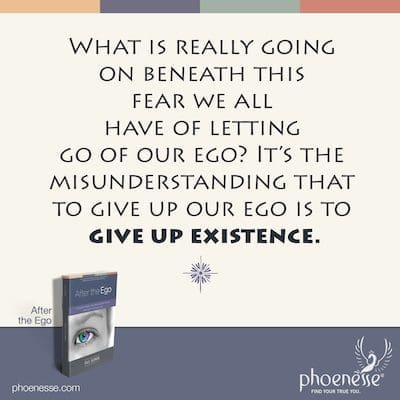
How fear derails us
Every step we take in the direction of truth is a step toward freedom. So if we truly have a genuine desire to be constructive and to participate in the creative process of life, this is the way we must go. What gets in the way is our fear of the unknown and our reluctance to let go. And yet the less open we are to seeing and knowing the truth, the less possibility there is to experience our spontaneous Real Self.
Let’s back up a step. What might it look like for this universal life principle to show up? We might suddenly receive wisdom for solving a personal problem that we previously hadn’t imagined before. Or maybe we’ll experience life in a new, vibrant way we hadn’t known before, adding flavor to what we’re doing and seeing.
This isn’t a trick. The Real Self is always safe and always holds out justified hope that we aren’t going to be disappointed. There’s no reason to fear this new way of experiencing life, and yet this isn’t something we can push, force or manipulate. It will happen all by itself, to exactly the same degree we no longer fear the involuntary processes.
Humanity now finds itself wrestling with deeply wanting the fruits of the Real Self and its involuntary processes, while at the same time fearing and battling them. This is a terrible conflict that traps us, and is deeply tragic. The only way to resolve it is to let go of our fear. And all of life is moving us towards this resolution.
Our work begins by finding and understanding what’s underneath our personal difficulties. What are the misconceptions we hold and what were the child experiences that led to them? We must see and accept what is real in ourselves, right now, as well as in others and in life. Honesty will be the best policy, as it will illuminate the many subtle and not-so-subtle ways we are hoping to cheat life.
We will need to face and reform our character defects. We do this by observing them, and not by plunging into despair when we see them and then denying we’ve ever done anything wrong. Fully acknowledging our faults is an infinitely more effective way to remove them than any other approach. And note, it’s not a question of removing them so then something good can happen. It’s really a question of being able to quietly observe ourselves in the defect. In that moment, we will perceive the existential conflict between our ego and our Real Self.
Our Real Self, which manifests spontaneously, has nothing to do with some religious concept or with a white-haired God living outside of us. It also has nothing to do with a heavenly life beyond this earthly one. These are misguided interpretations that have come about because we have sensed our Real Self—the universal consciousness or life principle—and groped for an explanation on the level of the ego. Because when the ego is still in conflict with the creative life principle, misinterpretations are bound to occur. As such, these false descriptions alienate us more from our immediate Real Self, and we then don’t experience it in our practical daily life.
So we may have a deep sense that there are more possibilities available to us, but we can’t seem to reach them. Worse, in our alienation, we’ve become frightened of our Real Self. Over time, people have come up with vague theories that try to bridge the gap between their yearning and their fear. If we look at any organized religion that removes God from the self and from the daily experience of life, we will find that a compromise exists which splits human nature into the physical being and the spiritual being. As such, total fulfillment gets taken out of the now and gets shoved off into life after death. Any views like this, though, are nothing more than an unfortunate compromise between what we sense could exist and what we fear.
This fear goes beyond the individual fears that arise from our mistaken beliefs and our personal childhood traumas. So then what really is going on beneath this pervasive fear we all have of letting go of our ego and allowing our Real Self to unfold and carry us along? It’s the misunderstanding that to give up our ego is to give up existence.
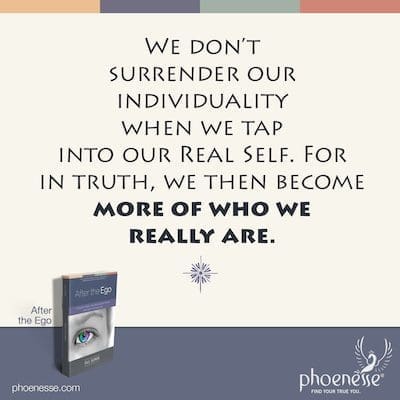
The illusion of separation
In order to understand this situation better, let’s look at how the ego formed itself from the Real Self. For starters, the creation of individuals comes from the inherent nature of the Real Self, or the creative life force. After all, life is always on the go, moving and expanding, reaching out and contracting, finding new ways to extend itself into new terrain. Creativity has to create. So life is forever discovering new possibilities for how it can experience itself.
But after a while, after an individual consciousness has drifted further and further from its original source, it “forgets” its connection and seems to be a totally separate entity. Eventually it loses touch with the laws that govern it and the creative principles that enliven it. This is how we come to have an individual existence that’s now only associated with being separate. In this case, giving up the ego may look alarmingly like annihilation of this unique person.
This is where we find ourselves today. We are under the illusion that “I” can only be found in my “separate” existence. This is exactly the illusion that has caused human death to come about. For death, as we know it, is nothing more than the extension of this illusion to its final—and really quite absurd—conclusion.
This is not some theory for us to consider with our mind. No, this is what we can realize, here and now, by looking at ourselves in truth. When we shed the illusions we hold about ourselves, we will see that we don’t surrender our individuality when we tap into our Real Self, letting the universal consciousness take over and integrate with our ego functions. For in truth, we then become more of who we really are.
When we are living from our Real Self, we experience a renewal of energy and, paradoxically, we find that the more we give of ourselves, the more energized we feel. For that’s the law of the universal life principle. By contrast, when we are operating from our ego and separated from our Real Self, we are locked in a land of duality. On this level, it seems entirely logical that the more we give, the less we will have and the more depleted we will become. This stems from the illusion that our outer ego is all there is to us, which is at the root of our fear of letting go of our tight ego defenses.
To be clear, it’s not just energy that we tap into. When we access these universal powers, we will also notice an influx of inspirations and ideas coming from an intelligence that’s much more vast than anything we’ve known before. Our outer intellect is no match for this inner wisdom. This is our “best self.” And while it may seem foreign to us at first, it is not. It’s just that these channels have been clogged for so long. This has been partly due to our ignorance that they even existed, together with all the personal little lies we’ve been telling ourselves and others.
This vaster intelligence will present itself in the form of guidance, intuition and inspiration. This will come, not as some vague feeling, but through concise words and helpful understandings we can readily grasp and apply to our everyday lives.
By discovering this new inner life, we will reconcile the apparent opposites of being an individual and being an integral part of the whole. Being a unique person as well as one with all that is will no longer appear to be opposites, but interdependent facts. This is the first of many such seemingly mutually exclusive alternatives which cause us so much heartache, and that will resolve when the ego connects with the Real Self.
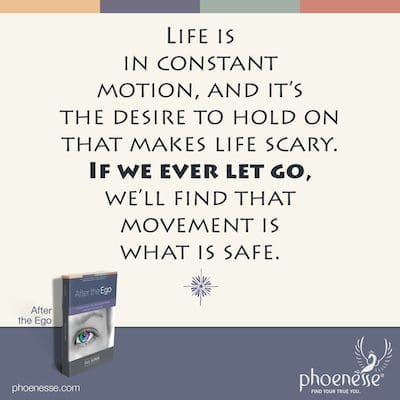
Finding real security
Letting go of the ego should not be misconstrued to mean it is disregarded in its importance, or let fall by the wayside. And most certainly it is not to be annihilated. For the ego has crafted itself as a separate part of the Real Self—which is our greater being that is found deep inside of us. Whenever the ego becomes ready to reconnect itself to its original source, the Real Self can be immediately accessed, if we desire to do so. This means that whenever the ego becomes strong enough to risk trusting the Real Self faculties that are greater than it is—especially given the ego’s very limited conscious capabilities—the ego will find a treat in the form of a new security we’ve never dreamed of.
What stops us from taking this step is the fear that we will be crushed. We’re afraid we’ll fall into nothingness and disappear. To help calm this fear, we grab onto the petrified, unmoving pieces of our psyche. For if it’s not moving, that must be a safe place to anchor ourselves, right? What’s moving, we think, must be dangerous. And yet in truth, it’s the opposite. Life is in constant motion, and it’s the desire to hold on that makes life scary.
If we ever let go, we’ll find that movement is what is safe. When movement carries us—when life carries us—we’ll have found the only real security there is. Any other false security—such as hanging on to anything for dear life—is pure illusion, and breeds nothing but more fear.
If we could peer behind the curtain of our own thoughts, we might discover a voice that says: “If I don’t hold on to myself, I am not safe.” If we start to notice a feeling like this, we are now holding an important key. For we now can consider the possibility that this is an error. In truth, we have nothing to fear. We are not going to be annihilated or crushed. We will only be carried.
The world we live in is created by our present state of consciousness, and not the other way around. Believe it or not, this is even true for physical laws. But we’re all so used to putting the effect first and the cause later. This comes from our dualistic state of thinking in which we are unable to see the whole picture and tend to think in an either/or way.
But truth be told, we are not randomly assigned to come live here. Rather, this dualistic sphere is an expression of where humanity is in its development. Everything contained here is an out-picturing of what’s inside us. For example, on planet Earth we have the physical law of gravity. This law is a match for our dualistic consciousness. It expresses, on the physical level, our reaction to and concern about falling and being crushed when we give up our ego as the sole form of our existence. Hence, the law of gravity is in perfect parallel with our inner conditions.
There are other spheres of consciousness that have different physical laws. Because the overall conscious of those individuals have transcended the duality that exists here. Our reality is not the last and only one that exists. We can ponder this as a way to widen our horizons in how we think about the boundaries of reality. By sensing that a different inner experience is real, our fear may lessen. Also, our illusion about having an isolated, ego-existence may diminish.
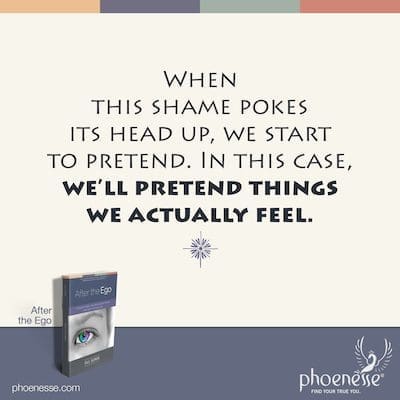
Working through layers of consciousness
How do we apply this information in our search to find our Real Self? Consider that such a search will bring us, unavoidably, to the task of sorting out the various layers of our consciousness. Our work will involve making previously unconscious material conscious so we can reorient our faults and wrong thinking. And the more we do this, the closer we will come to our Real Self.
As our Real Self becomes freer to reveal itself, we will be, more and more, released from our fears, shames and prejudices. And that makes us more available to our Real Self. Anyone who has done so can testify to this truth: The more courage we summon to take a brave look at the truth of what’s in us, the easier it becomes to connect with this vast, safe and blissful life within.
And the more we connect with the part of ourselves that removes any uncertainty and all conflict, the more secure we will feel in our ability to function in the world. Daily practical living gets easier, not by magic but by increasing our capacity to cope. Best of all, we open up our ability to experience greater pleasure, just as we are meant to. If we’ve become disconnected from this way of living, of course we are going to yearn for it!
If we break it down, there are three fundamental levels of the human personality. First, there is our Higher Self, which holds the greatest potential in each person. This is the universal life force that rests at the core of every human being. Covering over the Higher Self is the Lower Self. The Lower Self is made up all our faults and illusions, our destructiveness, negativity and cruelty. Layered over all this is a third component that we could call our Mask Self, or our Idealized Self Image. This layer is based on our pretense of being what we want to be, or what we feel we ought to be, in order for everyone to like us and approve of us.
There are many aspects to explore regarding these distinct parts of the self. But there is one particular phenomenon that bears mentioning about this topic of the ego and the Real Self. Strange as it may sound, we are often ashamed of our Higher Self—of the best in ourselves. Particularly for those who are the Will Type, it seems shameful to let others see our best, most loving and generous impulses. Somehow, we find it easier and not so embarrassing to show our worst side.
Let’s explore this a bit more deeply, as we can connect it with our fear of exposing our Real Self. Returning to the Will Type, such a personality may feel shame primarily about being loving or giving. They believe that if they give in to the demands of society to be good, they will lose their sense of themselves as an individual. They fear submitting to the opinions of others. For this might make them somehow dependent on another. They therefore feel ashamed of any impulse they may have to please someone else. As a result, a person who is a Will Type may feel more like “themselves” when they are being mean or aggressive.
In actual fact, many of us have a similar reaction to our Real Self and our real feelings of kindness, goodness and generosity. This strange shame shows up as embarrassment and a feeling of being exposed for being who and how we truly are. This is not the shame we feel about being deceitful or our destructive, or of giving in to someone’s demands. This is shame on a whole different level, and it’s of a very different quality. It’s the feeling that what we are feels shamefully naked, regardless of what we think or feel, or how we behave.
This is important to understand, for it explains the reason we create all these artificial layers. Usually we think of these masks, or defenses, as they arise from our misconceptions about life. In this case, as we begin to reveal the naked core of ourselves and our fear of danger abates, we now start to feel more ashamed. The danger alarms go off when our ego gives over to the involuntary processes of the Real Self. The shame, on the other hand, surfaces acutely when we start being who we truly are in the moment.
When this shame pokes its head up, we start to pretend. This particular pretense is different from our “normal” mask—power mask, love mask or serenity mask—that attempts to cover up our destructiveness, cruelty and general lack of integrity. This different pretense is actually deeper, and it’s more subtle. In this case, we’ll pretend things we actually feel.
So for example, in a case where we already feel love, we may hide our real love because it makes us feel naked. Instead, we create a false love. Or we may truly feel anger, as we are today, but since this anger feels so naked, we manufacture a false anger. Same for sadness. We might feel mortified to acknowledge our own sadness, even to ourselves, so we slap on a fake sadness that we can easily display to others. Perhaps we really are experiencing pleasure, but because this feels humiliating to expose, we create false pleasure. We’ll also fake things like confusion and being puzzled. Whatever our true emotion, we find a way to intensify and dramatize it, effectively faking it.
Walking around wearing this protective garment of fake feelings, we hide our Real Self. And we’re the only ones—usually deep in our unconscious—who knows we’re doing this. This “protective garment” of ours also acts like an anesthesia, numbing the vibrancy of life. For what we have done is built a screen between us and our Real Self. This effectively separates us from the reality of our own inner being, which we can’t stand but feel compelled to imitate. We are counterfeiting our own existence.
In the end, because the moving stream of life seems so dangerous to us, we act in ways that affect our personal dignity. What a tragic illusion! For the stark truth is this: We can only be truly safe when we reunite with the source of all that life is, and then we will find true dignity. For then we will overcome the shame we feel about being real, however that is showing up in this moment.
Often, we’d rather be annihilated than bear this strange sense of shame that comes from exposing our true being. Friends, this is incredibly important to look at and not push away when it arises. This is not a trivial thing, and looking this directly in the face will take us a long way on our path. It holds the key to unlocking our numbness that leads to despair and frustration. And that numbness contributes to self-alienation and feeling a particular kind of unpleasant disconnectedness.
It’s difficult to put our finger on this subtle fakery, for it’s not easy to identify the true feeling from the false. We won’t be able point it out with mere words. Instead, we must notice how the flavor and quality of our experiences is off. And often we’ve been doing this for so long, it’s by now second nature. So we’ll need to do some very sensitive letting go, while letting ourselves be and letting ourselves feel, and closely watching what we discover.
Now is not the time to rush ahead. We will need to slow down and become exquisitely aware of what happens when we expose our naked feelings. What we may also notice is that our subtle imitations produce opposite feelings, in addition to the identical ones. And our intensification of things makes the false appear real.
So if our goal is to become more authentic, this is the ground we will have to traverse to get there. We can’t get there by going any other way. We will have to make peace with the shame of feeling naked. Then, when we do connect with our momentary Real Self, it won’t be “perfect.” Far from it. We’ve all got work to do. Yet what we are now is perfect in the way it contains all the seeds we need to live a deeply vibrant life.
We already are this universal life power, which holds everything good that is possible. And what we are right now is not shameful because we have some faults. In the same way, our naked Real Self is not something to be ashamed of. When we marshal the courage to become our Real Self, we can begin to take a whole new approach to life, letting all our pretenses fall away. This includes the easy-to-spot masks we all walk around wearing—well, easy to see in others and typically harder to identify in ourselves—as well as these more subtle cloaks.
But these are exactly what’s standing between our ego and our Real Self. They create a screen that blocks the life force and alienates us from our best self. And they form a chasm that seems dangerous to cross. They are also the cause of our illusory feelings of fear and shame. This shame originates from some of our fears and leads to the creation of others. This shame is as basic as the fears themselves that are responsible for our misconceptions about life and our splits. These are all threads in the same ball of illusion.
We can see the symbolism of the shame about our nakedness reflected in the story of Adam and Eve. To be naked, in reality, is to be in paradise. For when we stop denying our nakedness, we can begin to live a new blissful life. And this can happen right here, right now, not in another life in the beyond. We won’t arrive here in a day, of course. We’ll have to acclimate ourselves to this way of walking in the world, naked as it were and free from shame.
As we walk on our spiritual path in the outer world, we will also have to walk another path inside. A path within a path, if you will. This is the way we must go to become aware of our ingrained habit of covering up our inner nakedness. And this won’t be an easy habit to break! But once we start paying attention to all this and call on the powers available to us—over and over, we need to ask for help and guidance—we’ll begin to notice our shame and our hiding.
Bit by bit, we will learn how to drop our cloak and step out of our protective shell. Every day we do this, we will become more real. Not better. Not worse. And not different from the way we are. Without the counterfeit feelings, we’ll just be more real. We’ll venture out into the world as we happen to be right now.
Getting started
We can start by considering the possibility that our feelings may be put on. We don’t need to be frightened by this idea, and yet many people are terrified of this notion that their feelings may be fake. We’re afraid that if our feelings aren’t real, we have no feelings. We fear our own emptiness. And we are devastated by this fear. This fear will prod us to go on pretending.
If we keep peeling back the layers, we’ll eventually come to the place where we say, “No. I don’t want to feel.” This might come from what we’ve been discussing here, or it may stem from childhood traumas. Matters not. The point is, there must always be an inner resolve not to feel. Often, we’ve lost our connection with this resolve, meaning it has slipped down into our unconscious. As a result, our conscious selves are helpless about the result, which is that we have no feelings.
What we do feel is the terror of not being able to feel, and this terror is way worse when our conscious self is ignorant of what’s going on in our unconscious where we fear feelings. It may help to realize that no one is really without feelings, and feelings can never permanently die. Life and feelings are one, so if there is life, there are feelings, even if they’ve been shut down. So knowing this, we can ask inside, “Where have I made the decision not to feel?” Notice the fear come up about feeling feelings? Now we’re onto something.
The next step is to reactivate our feelings by using our reasoning mind—here’s where the ego comes in and asks for help from our Higher Self—and involving a rational evaluation of the circumstance. This is the work. What surfaces will not kill us, as the parts of us still living in child consciousness may believe. But to not feel…that’s what it’s like to stop living.
“Be blessed, every one of you. May your endeavors succeed to become real, to find the courage to be nakedly real without any false covers. You cannot help but succeed if you really want to. Those who do not move and grow and liberate themselves do not want to — and it is important to know this — and find in you the inner voice that refuses to move. May all your false layers fall away because this is what you really want and decide. You will then discover the glory of living. Be in peace, be in God!”
–The Pathwork Guide

Next Chapter
Return to After the Ego Contents
Read Original Pathwork Lecture #152: Connection Between the Ego and the Universal Power

